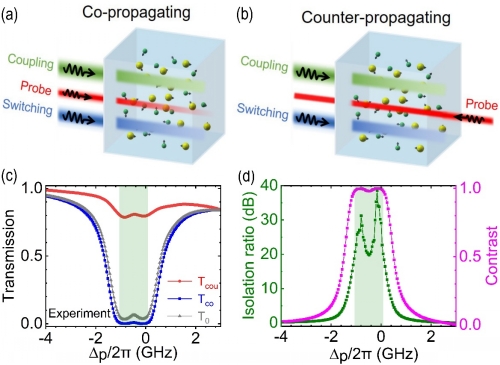Recently, a research team led by Prof. Yong-Chun Liu at Department of Physics, Tsinghua University, discovers that the collision of thermal atoms can induce high-performance optical nonreciprocity. They experimentally achieved optical nonreciprocity with high isolation (~40dB), ultrabroad bandwidth (> 1.2GHz) and low insertion loss (< 1dB), simultaneously. The study paves the way for the realization of high-performance optical nonreciprocal devices and provides opportunities for applications in integrated optics and quantum networks. This work has been published in Physical Review Letters with the title “Collision-Induced Broadband Optical Nonreciprocity”.
Lorentz reciprocity theorem shows that if the source and the observation point is exchanged, their relation remains unchanged. At optical frequencies, the realization of nonreciprocal transmission of light is not only of great significance in basic scientific research, but also plays an indispensable role in the design of isolators, circulators, directional amplifiers and other devices.

FIG. 1Schematic diagram of the experiments and typical experimental results. (a)(b) is the schematic diagram of the experiments setting. (a) for copropagating and (b) for counterpropagating. (c) is the experimental results for the probe laser transmission spectra with corresponding isolation and contrast ratio shown in (d). The bandwidth for isolation ratios greater than 20 dB is denoted by shaded regions in the (c) and (d).
In general, thermal atom collisions have negative effects such as decoherence, which should be avoided in the experiments. This work discovers that atomic coherence is not the most important factor for optical nonreciprocity, while the atomic population difference between the state levels plays a more critical role. Based on an atomic vapor cell filled with rubidium 87 atom and buffer gas, two control beams (Coupling and Switching light in Fig. 1) are used to lock the population of the ground state energy level of rubidium 87 atom to the direction of the motion of the probe light, so that the probe light is strongly absorbed when it propagates in the same direction as the control light (copropagating), but hardly absorbed when it propagates in the opposite direction (counterpropagating), which means that nonreciprocal transmission of probe light is achieved. By combining the collision broadening caused by the collision of buffer gas atoms and the Doppler broadening caused by the thermal motion of atoms, and further utilizing the overlap of adjacent energy level resonance lines caused by the broadening, the bandwidth of isolation is greatly increased. Typical results of the experiment are shown in Fig. 1 (c) - (d), where the bandwidth for an isolation ratio exceeding 20 dB is over 1.2 GHz, which is more than two orders of magnitude broader than the natural linewidth of the atomic spectrum.
The co-first authors of the paper are graduate students Chao Liang, postdoctoral researcher Bei Liu (now is an associate researcher at Shandong University) from Department of Physics, Tsinghua University. The corresponding author is Associate Prof. Yong-Chun Liu. This work is supported by the Key-Area Research and Development Program of Guangdong Province, the National Natural Science Foundation of China (NSFC), and the National Key R&D Program of China.
Research link:https://journals.aps.org/prl/abstract/10.1103/PhysRevLett.125.123901